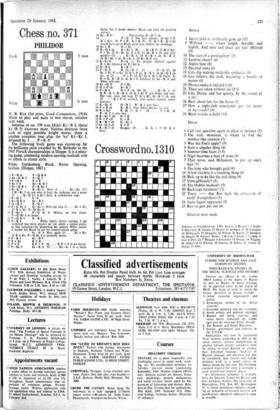Chess no. 371
PHILIDOR
W. B. Rice (1st prize, Good Companions, 1914). White to play and mate in two moves, solution next week.
Solution to no. 370 (van Dijk): Kt - B 3, threat Kt (B 5) discovers mate. Various defences force each of eight possible knight moves; there is another complete tour after the 'try' Kt - Kt 3, defeated by 1 . . . P - R 3!
The following lively game was runner-up for the brilliancy prize awarded by M. Betbeder in the 1967 French championships at Dieppe. It is a pleas- ing game, combining modern opening methods with an attack in classic style.
White, Goldenberg. Black, Ricter. Opening, Sicilian. (Dieppe, 1967.)
I P - K 4 P - Q B 4 .2 Kt-K B 3 P-Q 3 3 P -Q 4 P x P 4•Kt x P Kt - K B 3 5 Kt -Q B 3 P-K Kt 3 6 B- K 3 B - Kt 2. Note 6 . . . Kt - Kt 5??; • 7 B - Kt 5 ch and wins at least the exchange and a pawn (7 .. B -Q 2?: 8 Q X Kt!). A well-known trap. ' 7 P - B 3 0 - 0 8 B-QB 4 Kt-B3 9 Q -Q 2 B - Q 2 10 P - K Kt 4 Q - Kt 1. With the idea 11 . . . Kt x Kt; 12 B x Kt. P-Q Kt.4. II B - Kt 3 P - Q R 4. Mixing up two plans. ' P - Q Kt 4 is better.
12 P-QR 4 R-BI 13 P - R 4 . . . White rightly delays castling: I am surprised that more players do not adopt a similar policy in this variation-by preserving his options White makes it harder for Black to get his counter-attack going.
13 . . . Kt - K 4. Here again 13 . . . Kt X Kt; ' 14 B X Kt, P - Q Kt 4 is probably better. 14 P - R 5 Kt - B 5 15 B x Kt R x B 16 P x P B P x P 16 . . . R P x P is no better.
17 P - Kt 5 Kt - R. 4 17 . . . Kt - K 1 is a shade better but I doubt whether Black can hold the position anyway.
18 Kt - B 5! . . . Threatening Q-Q 5 ch.
18 . P - K 3! The best chance. 19 Kt X P. R x Kt!: 20 P X R, B X B P!: 21 Q X B, Q X Kt would have given Black good play despite the exchange. 19 Kt X B K x Kt 20 B-Q 4 ch K -Kt 1 20 ... K-B I?; 21 R X Kt!, P X R; 22 P -Kt 61, P X P; 23 Q -R 6 ch and wins quickly-23 . . . K - K 1; 24 Q-R 8 ch, K - B 2;
25 Q -Kt 7 ch. K -K 1; 26 B-B 6! etc.
21 0-0-0 B-K 1. To protect himself against R X Kt followed by P -Kt 6. 22 B-B 6 R -R 3 23 P -K 51 R (5)- B 3 23 . . . P - Q 4?; 24
KtXP1,PXKt;25 QXPc11.13-B 2: 26 Q-C1 8 eh etc. or 23 . . P X P: 24 Q -Q 8. Q X Q (bestk 25 R. x Q, K - B 2; 26 B X P followed by Kt -K 4 and White will win.
24 Kt - 51 P X Kt 25QxPeh B- B 2 26 P -K 6 R x P ch. Or 26 . . Q - K 1: 27 Q R -K 1, R -B 1; 28 Q X Kt P and White will win. The text, once the trap 27 K X R?, Q - B I ch and 28 . . B x P is avoided, only makes matters worse however.
27 K - Kt II Q - B 2 R - B 2 also loses.
28.P )< B ch K - B 1. Now White finishes in style. 29 R x Kt! R (R 3)- B 3 29 . P x R: 30 R - K 1! is also lost.
30 B - Kt 7 els! KXB 31 R x P ch! K x R 32 R - R I ch K - Kt 2 33 Q - Q 4 ch KXP
34 R - R 7 ch Resigns. 34 . . . K*- K 3: 35 Q - K 4
mate.


































 Previous page
Previous page